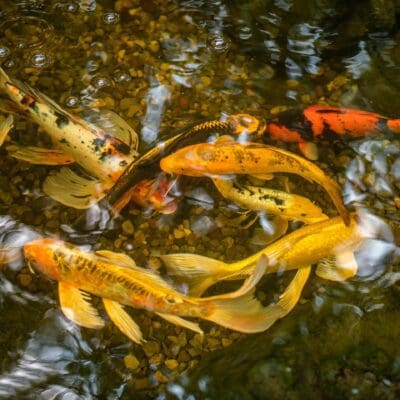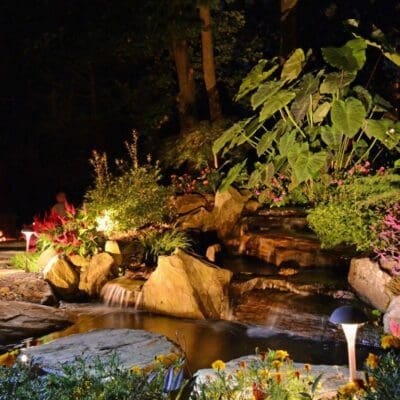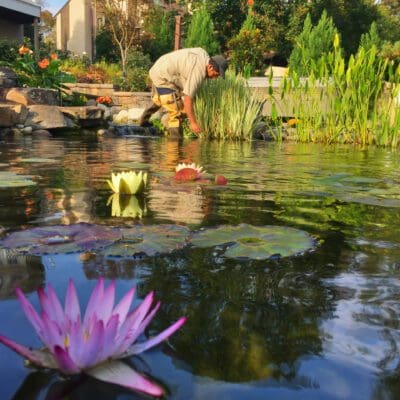Over the years, we’ve encountered countless koi pond myths. These myths often dissuade people from installing one and enjoying the unique benefits that come with them. Today, we’re here to debunk these common misconceptions and help shift the perspective on koi ponds.
A koi pond should be located in the lowest part of your yard!
This is one of the most misleading beliefs. Positioning a koi pond in the lowest part of your yard invites runoff, which can bring unwanted debris and pollutants. Instead, placing your pond near your house not only enhances its visual and auditory appeal during gatherings but also lets you appreciate its beauty from inside your home, like when enjoying your morning coffee.
You can’t be a koi hobbyist and a water gardener
False! Raising healthy koi and maintaining a vibrant water garden can go hand-in-hand. Your koi will thrive just as well in a well-maintained water garden as they would in a traditional setup, and your garden will flourish alongside them.
You have to bring your koi inside over winter
Not true. As long as your pond has a depth of at least two feet, your koi will survive even the harshest winters. The water will only freeze a few inches deep, so, with proper oxygenation and a small opening in the ice for gas exchange, your fish will be just fine.
More filtration means a better pond
This isn’t necessarily true. Overfiltering your pond can lead to constant maintenance and frustration. Natural ponds aren’t crystal-clear, and neither should yours be to an extreme degree. If you can see a dime at the bottom, your pond clarity is perfect. Anything beyond that can cause more stress than it’s worth.
UV lights are the only way to keep your water clear
While UV clarifiers can be effective, they are not essential. A naturally balanced pond that follows the ecosystem Mother Nature intended doesn’t need UV lights. When your pond’s ecosystem is in balance, maintenance becomes minimal as nature takes care of itself.
Rock and gravel make cleaning your koi pond very difficult
This is a misconception that needs debunking. Rocks and gravel provide a natural habitat for beneficial bacteria that help break down fish waste and debris, preventing the buildup of sludge. So, contrary to popular belief, incorporating rocks and gravel actually promotes a healthier pond environment and makes maintenance easier in the long run.
Predators will eat all of your expensive fish
Raccoons generally don’t like swimming and may only attempt to swipe at fish from the pond’s edge. Koi instinctively swim to deeper areas when threatened. While blue herons are a legitimate concern, planting water lilies and creating fish caves during excavation can provide added protection. For persistent herons, a motion-activated sprinkler called a scarecrow can be a humane and effective deterrent.
Koi can’t be kept in a pond with plants
This is far from true. Koi and aquatic plants can coexist and even thrive together in a naturally balanced pond. The plants provide natural filtration and nourishment, while koi contribute nutrients that the plants need to grow.
Your koi pond must be at least 3 feet deep to contain fish
Thousands of ponds around the country are only two feet deep and home to happy, healthy koi. Even in cold climates, a two-foot depth is sufficient because the ground acts as insulation, preventing the water from freezing beyond eight inches deep.
You can put your koi pond on a timer
This idea could harm your pond’s ecosystem. A koi pond requires continuous oxygenation to sustain beneficial bacteria and healthy fish. Shutting down the system at night disrupts this balance and can make it difficult for your koi to breathe. While pondless waterfall systems can be set on a timer, a koi pond should never be.
You can’t have a koi pond in an area with lots of trees
While more leaves may fall into the pond, this can be managed with a pond net during autumn. The shade provided by trees can actually help minimize algae growth in summer. A skimmer can also be installed to remove leaves and debris from the water’s surface with ease.
A koi pond means there will be a lot of mosquitoes
Mosquitoes breed in stagnant water, not in a well-maintained koi pond. If mosquitoes do lay eggs in your pond, the koi will view the larvae as a tasty snack, effectively keeping the mosquito population under control.
Koi ponds are unsafe and a liability
Safety concerns are valid, but a professionally designed water garden features gradual steps, making it far safer than a pool with steep drop-offs. The first step is typically ankle-deep, with deeper sections progressing in shallow increments. Educating children and guests about water safety is always a good idea. For those with liability concerns, a pondless waterfall is a great alternative.


